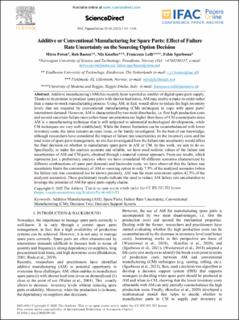| dc.description.abstract | Additive manufacturing (AM) has recently been reported as enabler of digital spare parts supply. Thanks to its promise to produce spare parts with shorter lead times, AM may enable a make-to-order rather than a make-to-stock manufacturing process. Using AM, in fact, would allow to reduce the high inventory levels that are required by conventional manufacturing (CM) techniques to cope with spare parts’ intermittent demand. However, AM is characterized by two main drawbacks, i.e. first high production costs and second uncertain failure rates (often these uncertainties are higher than those of CM counterparts since AM is a manufacturing technique that is still subjected to substantial technological developments, while CM techniques are very well-established). While the former limitation can be counterbalanced with lower inventory costs, the latter remains an open issue, so far barely investigated. To the best of our knowledge, although researchers have considered the impact of failure rate uncertainties on the inventory costs and the total costs of spare parts management, no one has investigated how the failure rate uncertainty would affect the final decision on whether to manufacture spare parts in AM or CM. In this work, we aim to do so. Specifically, to make the analysis accurate and reliable, we have used realistic values of the failure rate uncertainties of AM and CM parts, obtained through a material science approach. From our results, which represents just a preliminary analysis where we have considered 40 different scenarios characterized by different combinations of spare part demands and backorder costs, we have observed that the failure rate uncertainty limits the conveniency of AM as sourcing option to only 7.5% of the analyzed scenarios (when the failure rate was considered too be known precisely, AM was the most convenient option 42.5% of the analyzed scenarios). These preliminary results indicate the need to reduce AM failure rate uncertainties to leverage the potential of AM for spare parts supply chains. | en_US |

